Movement From Traditional to Modern Cost Accounting Methods in Manufacturing Companies
Added on 2023-05-27
26 Pages8219 Words162 Views
155
Movement From Traditional to Modern
Cost Accounting Methods in
Manufacturing Companies (*)
Hrvoje Perčević
University of Zagreb, Croatia
Mirjana Hladika
University of Zagreb, Croatia
Abstract
Significant changes in business environment at the end of 20th century and
the beginning of 21st century enable the development and application of modern
cost accounting methods which main purpose is to give required information to
management regarding the effectiveness of certain products, projects, activities,
consumers, responsibility centres etc. Traditional cost accounting methods were
developed in the middle of 20th century due to the automation of production. The
focus of traditional cost accounting methods was on manufacturing cost and ways
of indirect manufacturing costs allocation to products or services. But, further
development of technology, changes in consumer’s preferences, global competition
face modern manufacturing companies with permanent challenges of survival at
the global market. Traditional cost accounting methods are no longer appropriate in
modern business conditions, because cost accounting methods should indicate the
potential areas in companies where are possible cost savings. Therefore, modern
cost accounting methods are focused on cost rationalization and cost reduction,
since modern manufacturing companies cannot effect on market prices but can
effect on their costs. In current business conditions, modern cost accounting methods
(*) Bu Araştırma, 19-22 Haziran 2013 tarihinde İstanbul’da yapılan 3rd
International Conference on Luca Pacioli in Accounting History’de ve 3rd Balkans
and Middle East Countries Conference on Accounting and Accounting History
(3 BMAC) Konferansı’nda bildiri olarak sunulmuştur.
Movement From Traditional to Modern
Cost Accounting Methods in
Manufacturing Companies (*)
Hrvoje Perčević
University of Zagreb, Croatia
Mirjana Hladika
University of Zagreb, Croatia
Abstract
Significant changes in business environment at the end of 20th century and
the beginning of 21st century enable the development and application of modern
cost accounting methods which main purpose is to give required information to
management regarding the effectiveness of certain products, projects, activities,
consumers, responsibility centres etc. Traditional cost accounting methods were
developed in the middle of 20th century due to the automation of production. The
focus of traditional cost accounting methods was on manufacturing cost and ways
of indirect manufacturing costs allocation to products or services. But, further
development of technology, changes in consumer’s preferences, global competition
face modern manufacturing companies with permanent challenges of survival at
the global market. Traditional cost accounting methods are no longer appropriate in
modern business conditions, because cost accounting methods should indicate the
potential areas in companies where are possible cost savings. Therefore, modern
cost accounting methods are focused on cost rationalization and cost reduction,
since modern manufacturing companies cannot effect on market prices but can
effect on their costs. In current business conditions, modern cost accounting methods
(*) Bu Araştırma, 19-22 Haziran 2013 tarihinde İstanbul’da yapılan 3rd
International Conference on Luca Pacioli in Accounting History’de ve 3rd Balkans
and Middle East Countries Conference on Accounting and Accounting History
(3 BMAC) Konferansı’nda bildiri olarak sunulmuştur.

156
are more appropriate while they are focused on the total costs through the whole
product life cycle. This paper deals with the modern cost accounting methods and
their application in manufacturing companies. The results are showing that modern
cost accounting methods enables more confidential determination of the real product
profitability. But it is also important to state that research results show that modern
cost accounting methods should be applied together with traditional cost accounting
methods. Traditional cost accounting methods give information regarding cost in
short term, while modern methods are orientated on longer period (e. g. on the whole
product life cycle).
Key words: Traditional Cost Accounting Methods, Modern Cost Accounting
Methods, ABC, Target Costing, Life Cycle Costing, Product Profitability.
Jel Classificiation: M21, M4A, M51
1. Introduction
The basic purpose of costing systems is to determine the cost of a
product or service by assigning manufacturing costs to products or services
that company produces or provides. Costing system consist of different
accounting methods used in order to define the cost per unit. Accounting
methods used in costing system enable the evaluation of products as a result
from the manufacturing process. It is important to point out that different
costing systems differently affect the product evaluation. The choice of
costing system was based on the type of the production process. Therefore,
job order costing was used in job order production, while process costing
was applied in process or mass production. Today, these two costing systems
are considered as traditional costing systems which are no longer suitable to
use in modern operating conditions. Business conditions are changing rapidly
becoming more and more complex. Manufacturing processes in modern
production companies are almost fully automated and computerized. The
process of manufacturing automation and computerization causes significant
change in manufacturing cost structure. The most important cost element in
modern manufacturing cost structure becomes indirect manufacturing costs
are more appropriate while they are focused on the total costs through the whole
product life cycle. This paper deals with the modern cost accounting methods and
their application in manufacturing companies. The results are showing that modern
cost accounting methods enables more confidential determination of the real product
profitability. But it is also important to state that research results show that modern
cost accounting methods should be applied together with traditional cost accounting
methods. Traditional cost accounting methods give information regarding cost in
short term, while modern methods are orientated on longer period (e. g. on the whole
product life cycle).
Key words: Traditional Cost Accounting Methods, Modern Cost Accounting
Methods, ABC, Target Costing, Life Cycle Costing, Product Profitability.
Jel Classificiation: M21, M4A, M51
1. Introduction
The basic purpose of costing systems is to determine the cost of a
product or service by assigning manufacturing costs to products or services
that company produces or provides. Costing system consist of different
accounting methods used in order to define the cost per unit. Accounting
methods used in costing system enable the evaluation of products as a result
from the manufacturing process. It is important to point out that different
costing systems differently affect the product evaluation. The choice of
costing system was based on the type of the production process. Therefore,
job order costing was used in job order production, while process costing
was applied in process or mass production. Today, these two costing systems
are considered as traditional costing systems which are no longer suitable to
use in modern operating conditions. Business conditions are changing rapidly
becoming more and more complex. Manufacturing processes in modern
production companies are almost fully automated and computerized. The
process of manufacturing automation and computerization causes significant
change in manufacturing cost structure. The most important cost element in
modern manufacturing cost structure becomes indirect manufacturing costs
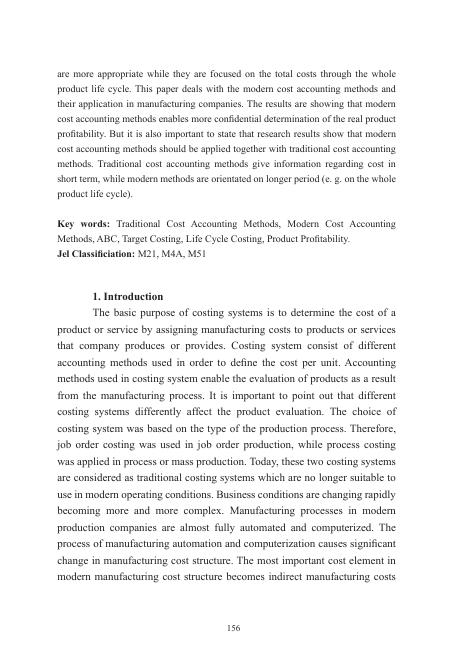
157
(manufacturing overheads). This change in manufacturing cost structure
found traditional costing systems inappropriate for product evaluation.
In order to avoid the inaccuracy of traditional costing systems in product
evaluation, the new costing system, based on activities, has been developed.
This costing system is known as Activity based costing.
2. The Types of Costing Systems
Costing system can be defined as a system used to assign costs to
cost objects (products or services). The main purpose of costing system is to
enable cost assignment. Cost assignment is the process of assigning direct
and indirect costs to products or services in order to determine the cost of a
product or service.
Each costing system consists of five basic elements:1
1. cost object – anything for which a measurement of cost is
desired. Usually, cost objects are products or services that certain company
manufactures or provides.
2. direct costs of a cost object – these are costs that can be traced to
a particular product or service
3. indirect costs of a cost object – these are costs that cannot be traced
to a particular product or service. Indirect costs need to be allocated to cost
objects using a proper cost allocation method.
4. cost pool – a grouping of individual cost item. The cost pools are
formed when company uses more cost allocation bases. In ABC system, cost
pools are identified activities to which indirect costs are assigning.
5. cost allocation base – the factor that links in a systematic way an
indirect cost (or group of indirect cost) to a particular cost object.
1) Horngren, C.T., Datar, S.M., Foster, G. (2003), Cost Accounting – A
Managerial Emphasis, Prentice Hall, New Jersey, p. 96-97.
(manufacturing overheads). This change in manufacturing cost structure
found traditional costing systems inappropriate for product evaluation.
In order to avoid the inaccuracy of traditional costing systems in product
evaluation, the new costing system, based on activities, has been developed.
This costing system is known as Activity based costing.
2. The Types of Costing Systems
Costing system can be defined as a system used to assign costs to
cost objects (products or services). The main purpose of costing system is to
enable cost assignment. Cost assignment is the process of assigning direct
and indirect costs to products or services in order to determine the cost of a
product or service.
Each costing system consists of five basic elements:1
1. cost object – anything for which a measurement of cost is
desired. Usually, cost objects are products or services that certain company
manufactures or provides.
2. direct costs of a cost object – these are costs that can be traced to
a particular product or service
3. indirect costs of a cost object – these are costs that cannot be traced
to a particular product or service. Indirect costs need to be allocated to cost
objects using a proper cost allocation method.
4. cost pool – a grouping of individual cost item. The cost pools are
formed when company uses more cost allocation bases. In ABC system, cost
pools are identified activities to which indirect costs are assigning.
5. cost allocation base – the factor that links in a systematic way an
indirect cost (or group of indirect cost) to a particular cost object.
1) Horngren, C.T., Datar, S.M., Foster, G. (2003), Cost Accounting – A
Managerial Emphasis, Prentice Hall, New Jersey, p. 96-97.
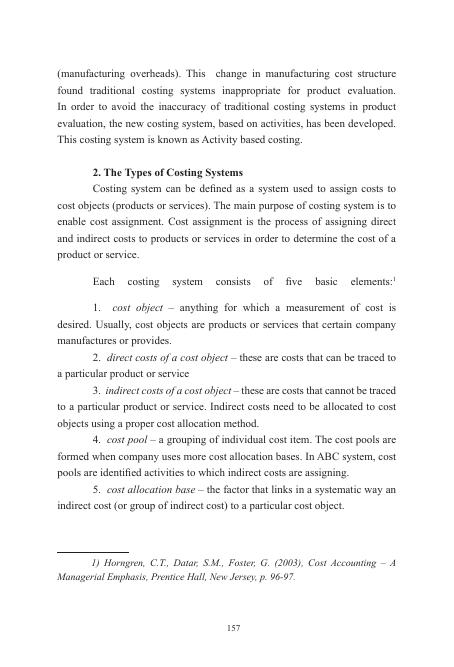
158
These five elements are using to design an adequate costing system.
There are three basic costing systems used in
manufacturing companies in order to determine the cost of
a particular product or to evaluate product profitability:2
1. job order costing,
2. process costing,
3. activity based costing.
The first two costing systems are known as traditional costing
systems. While the appliance of traditional costing systems depend on the
type of a manufacturing process, activity based costing system can be applied
regardless the type of manufacturing process. The main issue for companies is:
when is convenient to use traditional costing systems and when activity based
costing system should be applied? To answer on this question the operating
conditions and the manufacturing cost structure should be considered.
2.1. Cost allocation in traditional costing systems
The basic distinction between job costing and process costing system
is in determination of cost object. In job costing cost object is a job which
consists of a unit or multiple units of distinct products or services. In process
costing cost object is masses of identical or similar units of a product or service.
Therefore, job costing can be applied in manufacturing which is initiated by a
customer’s order, while process costing can be used in mass production which
is continually performing and is not initiated by a customer’s order.
Cost allocation is similar in job costing and in process costing. In
both costing systems direct manufacturing costs are traced to products or
services. These costs are directly assigned to particular products or services
which cause their appearance. Direct manufacturing costs include direct
material costs and direct labour costs. The main problem of every costing
system is indirect manufacturing costs allocation. Because these costs cannot
2) Lucey, T. (1996), Costing, DP Publications, London, p. 175-176.
These five elements are using to design an adequate costing system.
There are three basic costing systems used in
manufacturing companies in order to determine the cost of
a particular product or to evaluate product profitability:2
1. job order costing,
2. process costing,
3. activity based costing.
The first two costing systems are known as traditional costing
systems. While the appliance of traditional costing systems depend on the
type of a manufacturing process, activity based costing system can be applied
regardless the type of manufacturing process. The main issue for companies is:
when is convenient to use traditional costing systems and when activity based
costing system should be applied? To answer on this question the operating
conditions and the manufacturing cost structure should be considered.
2.1. Cost allocation in traditional costing systems
The basic distinction between job costing and process costing system
is in determination of cost object. In job costing cost object is a job which
consists of a unit or multiple units of distinct products or services. In process
costing cost object is masses of identical or similar units of a product or service.
Therefore, job costing can be applied in manufacturing which is initiated by a
customer’s order, while process costing can be used in mass production which
is continually performing and is not initiated by a customer’s order.
Cost allocation is similar in job costing and in process costing. In
both costing systems direct manufacturing costs are traced to products or
services. These costs are directly assigned to particular products or services
which cause their appearance. Direct manufacturing costs include direct
material costs and direct labour costs. The main problem of every costing
system is indirect manufacturing costs allocation. Because these costs cannot
2) Lucey, T. (1996), Costing, DP Publications, London, p. 175-176.
Shubham Mishra_JPR
12/11/2018, 11:33:17 AM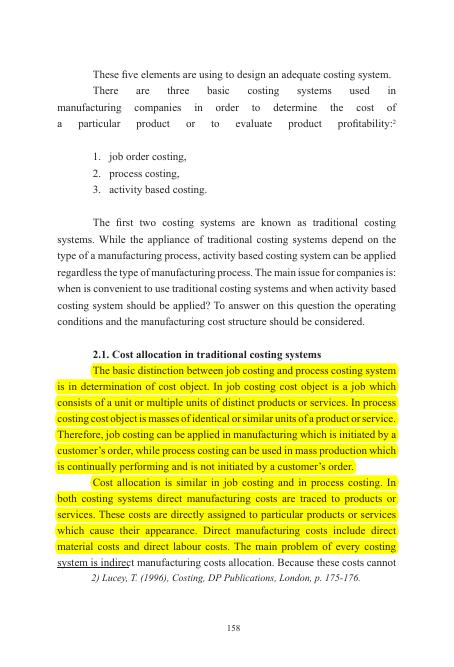
159
be directly identified to particular product or service, indirect manufacturing
costs need to be allocated to products or services on some reasonable bases
which correctly present the relationship between indirect manufacturing
costs and certain product. This relationship is often very difficult to
express by a single allocation base. It is important to emphasise that there
is no allocation base which can accurately provide indirect cost allocation
to products. Chosen cost allocation base can be more or less objective,
but it can’t be 100% accurate. Indirect manufacturing costs are usually
assigned to products or services using the following cost allocation bases:3
1. direct labour hours,
2. machine hours,
3. direct material costs,
4. total direct costs,
5. quantity of production.
Indirect manufacturing costs are assigned to cost object by an
overhead allocation rate which is computing on the chosen cost allocation base.4
total indirect manufacturing costs
OAR = --------------------------------------------
cost allocation base
Companies can use either one or more overhead allocation rate for
assigning indirect manufacturing costs to products or services. It is considered
that the more overhead allocation rates are used the cost per unit is more
accurate and the product profitability evaluation is more reliable and more
objective for decision making.
3) Engler, C. (1988), Managerial Accounting, Irwin, Homewood, Illinois,
p. 427
4) Lucey, T. (1996), Costing, DP Publications, London, p. 88
be directly identified to particular product or service, indirect manufacturing
costs need to be allocated to products or services on some reasonable bases
which correctly present the relationship between indirect manufacturing
costs and certain product. This relationship is often very difficult to
express by a single allocation base. It is important to emphasise that there
is no allocation base which can accurately provide indirect cost allocation
to products. Chosen cost allocation base can be more or less objective,
but it can’t be 100% accurate. Indirect manufacturing costs are usually
assigned to products or services using the following cost allocation bases:3
1. direct labour hours,
2. machine hours,
3. direct material costs,
4. total direct costs,
5. quantity of production.
Indirect manufacturing costs are assigned to cost object by an
overhead allocation rate which is computing on the chosen cost allocation base.4
total indirect manufacturing costs
OAR = --------------------------------------------
cost allocation base
Companies can use either one or more overhead allocation rate for
assigning indirect manufacturing costs to products or services. It is considered
that the more overhead allocation rates are used the cost per unit is more
accurate and the product profitability evaluation is more reliable and more
objective for decision making.
3) Engler, C. (1988), Managerial Accounting, Irwin, Homewood, Illinois,
p. 427
4) Lucey, T. (1996), Costing, DP Publications, London, p. 88
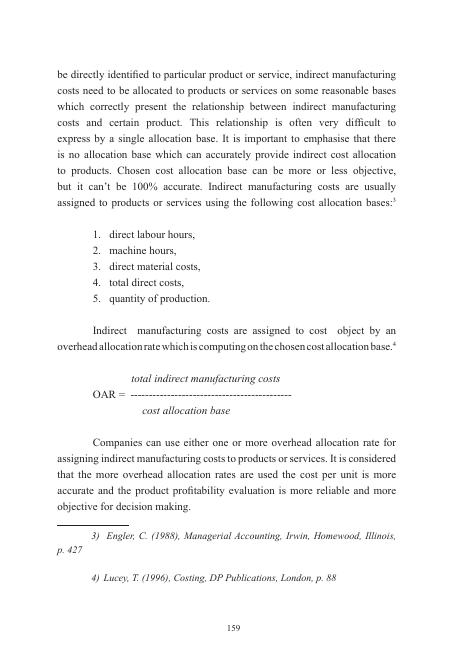
160
Figure 1. Cost allocation in traditional costing systems
In traditional costing systems the indirect manufacturing costs are
allocated to cost objects on arbitrary bases which could affect on product
profitability evaluation. The impact of traditional costing systems appliance
on product profitability evaluation depends on certain conditions among
which is manufacturing cost structure considered as the most important. If
indirect manufacturing costs participate significantly in total manufacturing
costs, traditional costing system may cause the wrong picture of product
profitability evaluation. Otherwise, traditional costing system can provide
relatively objective product profitability evaluation.
2.2. Cost allocation in Activity Based Costing System
Activity Based Costing system (ABC system) was designed in
order to correct the deficiencies of traditional costing systems. The initial
purpose of ABC system is to provide the fair and accurate cost allocation
Cost allocation base
Overhead allocation rate
COST OBJECT –
Direct material costs Direct labour costs
Manufacturing overheads
Figure 1. Cost allocation in traditional costing systems
In traditional costing systems the indirect manufacturing costs are
allocated to cost objects on arbitrary bases which could affect on product
profitability evaluation. The impact of traditional costing systems appliance
on product profitability evaluation depends on certain conditions among
which is manufacturing cost structure considered as the most important. If
indirect manufacturing costs participate significantly in total manufacturing
costs, traditional costing system may cause the wrong picture of product
profitability evaluation. Otherwise, traditional costing system can provide
relatively objective product profitability evaluation.
2.2. Cost allocation in Activity Based Costing System
Activity Based Costing system (ABC system) was designed in
order to correct the deficiencies of traditional costing systems. The initial
purpose of ABC system is to provide the fair and accurate cost allocation
Cost allocation base
Overhead allocation rate
COST OBJECT –
Direct material costs Direct labour costs
Manufacturing overheads
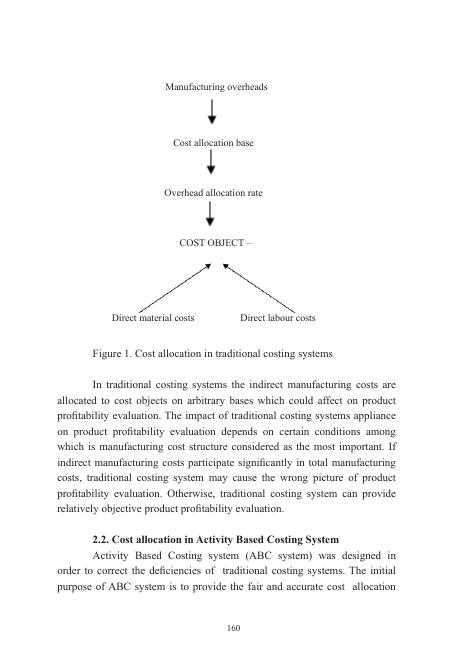
End of preview
Want to access all the pages? Upload your documents or become a member.
Related Documents
Accounting and finance Assignment PDFlg...
|7
|1804
|172
Management Accounting - Assignment PDFlg...
|9
|1846
|161
Management Accounting - Assignment PDFlg...
|7
|1472
|157
Product Costing and Pricing Doclg...
|8
|2193
|96
Management Accounting for Costs and Control - Assignmentlg...
|14
|2536
|43
SUSTAINABLE DESIGN PROCESS 2022lg...
|9
|1273
|31
